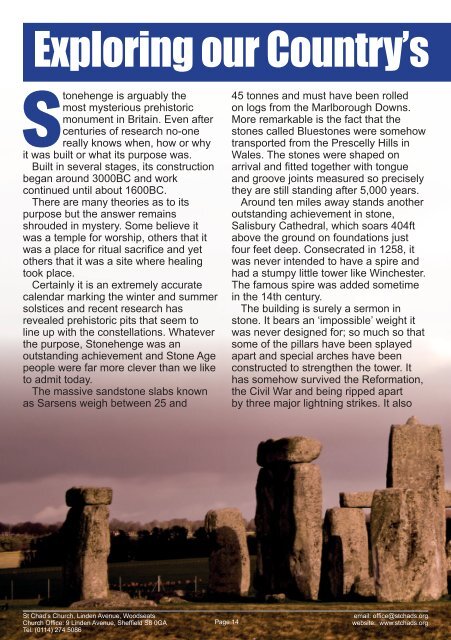You also want an ePaper? Increase the reach of your titles
YUMPU automatically turns print PDFs into web optimized ePapers that Google loves.
Exploring our Country’s<br />
Mysteries in Stone<br />
Stonehenge is arguably the<br />
most mysterious prehistoric<br />
monument in Britain. Even after<br />
centuries of research no-one<br />
really knows when, how or why<br />
it was built or what its purpose was.<br />
Built in several stages, its construction<br />
began around 3000BC and work<br />
continued until about 1600BC.<br />
There are many theories as to its<br />
purpose but the answer remains<br />
shrouded in mystery. Some believe it<br />
was a temple for worship, others that it<br />
was a place for ritual sacrifi ce and yet<br />
others that it was a site where healing<br />
took place.<br />
Certainly it is an extremely accurate<br />
calendar marking the winter and summer<br />
solstices and recent research has<br />
revealed prehistoric pits that seem to<br />
line up with the constellations. Whatever<br />
the purpose, Stonehenge was an<br />
outstanding achievement and Stone Age<br />
people were far more clever than we like<br />
to admit today.<br />
The massive sandstone slabs known<br />
as Sarsens weigh between 25 and<br />
45 tonnes and must have been rolled<br />
on logs from the Marlborough Downs.<br />
More remarkable is the fact that the<br />
stones called Bluestones were somehow<br />
transported from the Prescelly Hills in<br />
Wales. The stones were shaped on<br />
arrival and fi tted together with tongue<br />
and groove joints measured so precisely<br />
they are still standing after 5,000 years.<br />
Around ten miles away stands another<br />
outstanding achievement in stone,<br />
Salisbury Cathedral, which soars 404ft<br />
above the ground on foundations just<br />
four feet deep. Consecrated in 1258, it<br />
was never intended to have a spire and<br />
had a stumpy little tower like Winchester.<br />
The famous spire was added sometime<br />
in the 14th century.<br />
The building is surely a sermon in<br />
stone. It bears an ‘impossible’ weight it<br />
was never designed for; so much so that<br />
some of the pillars have been splayed<br />
apart and special arches have been<br />
constructed to strengthen the tower. It<br />
has somehow survived the reformation,<br />
the Civil War and being ripped apart<br />
by three major lightning strikes. It also<br />
Salisbury Cathedral<br />
escaped Victorian ‘Beautifi cation’ and<br />
World War Two bombs and yet it bears<br />
its burdens lightly as it stands today as it<br />
did 700 years ago, serene and ethereal.<br />
Though the stonework bears evidence<br />
of the passing centuries and reveals<br />
the scars of aging and battling with the<br />
elements, it has developed a living colour<br />
created by lichens and mosses which<br />
changes from green, through honeygold<br />
to grey with the seasons and the<br />
changing light.<br />
Like Stonehenge, Salisbury Cathedral<br />
stands as a landmark, a beacon, drawing<br />
tourists and pilgrims from far and wide.<br />
Many have been encaptured by the<br />
cathedral and many have participated<br />
in an unbroken round of worship since<br />
1225; many have worked to build it<br />
and many more to maintain it for future<br />
generations.<br />
In 1909 a traveller wrote about the<br />
effect the cathedral had on him:<br />
“One marvels at a building so vast in<br />
size which yet produces the effect of<br />
a palace in fairyland, or of a cathedral<br />
not built with hands but brought into<br />
existence by a miracle. I begin to think it<br />
is not safe to stay in that place too long,<br />
lest it should compel me to stay there<br />
always, or cause me to feel dissatisfi ed<br />
and homesick when away.”<br />
WH Hudson from A Foot In England 1909<br />
Sylvia Bennett<br />
St Chad’s Church, Linden Avenue, Woodseats<br />
Church Offi ce: 9 Linden Avenue, Sheffi eld S8 0GA<br />
Tel: (0114) 274 5086<br />
email: offi ce@stchads.org<br />
St Chad’s Church, Linden Avenue, Woodseats<br />
Page 14 website: www.stchads.org<br />
Church Offi ce: 9 Linden Avenue, Sheffi eld S8 0GA<br />
Page 15<br />
Tel: (0114) 274 5086<br />
email: offi ce@stchads.org<br />
website: www.stchads.org


















